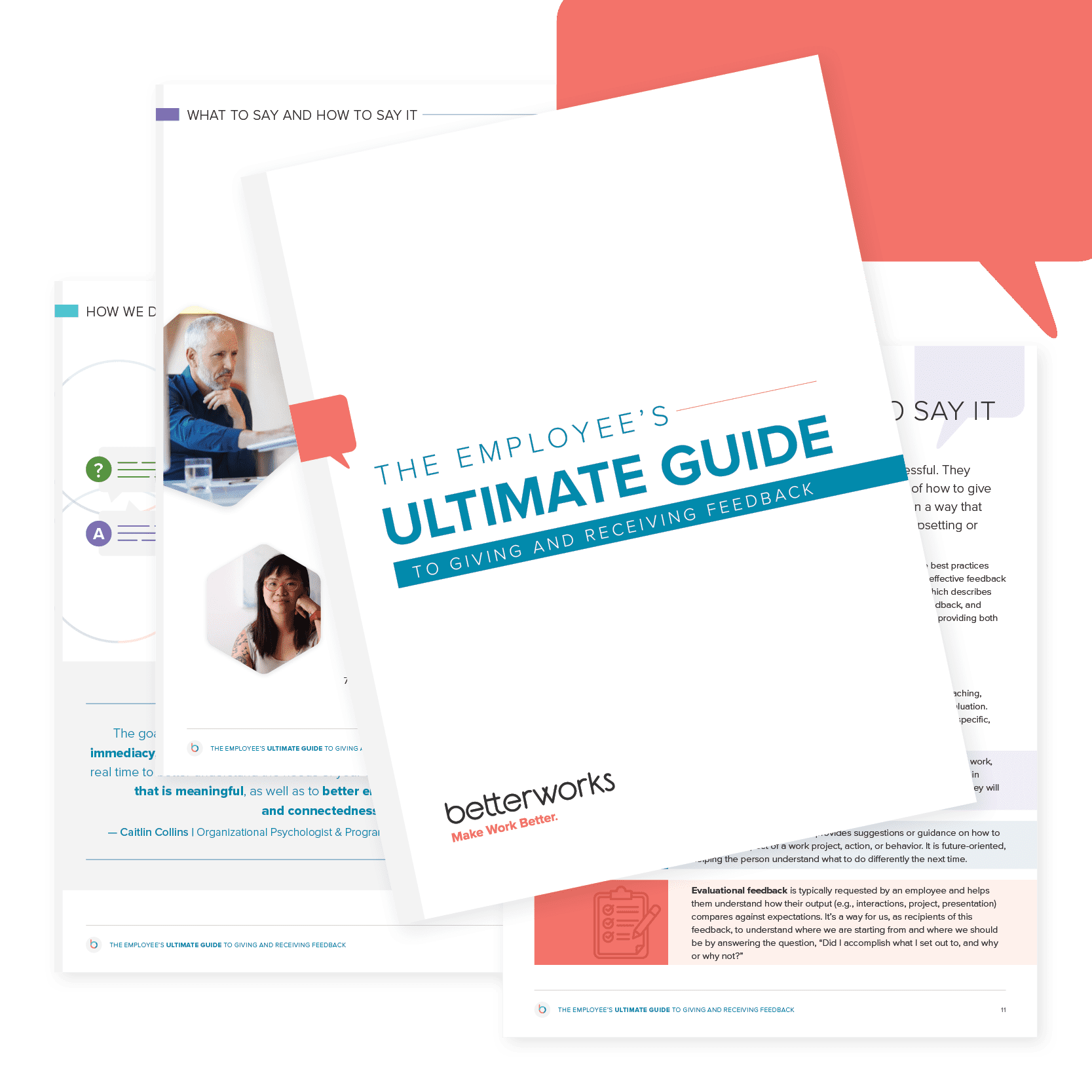- 3 key components of effective performance evaluation
- Breaking down different employee performance evaluation processes
- What’s the best approach for performance reviews?
- Choosing the right employee performance evaluation tool
- 6 best practices for performance evaluation
- Final thoughts: Elevating performance evaluation practices
- Employee performance evaluation FAQ
Nearly half (46%) of employees responding to our 2024 State of Performance Enablement report believe that performance evaluations alone, isolated from conversations and feedback from their managers, are a waste of their time. So why do organizations still use them?
Traditionally, employee performance evaluations are meant to benchmark performance and provide direction for improvement. In practice, however, annual reviews fail to capture the scope of an employee’s contributions to the business. And when these conversations only happen once a year, employees can feel blindsided by negative and biased feedback. That doesn’t mean that employee performance evaluations offer no value at all, though. When set within a performance enablement model, evaluations help employees see their progress toward goals and provide insights into both their strengths and areas for improvement.
That’s because performance enablement focuses on ongoing support and real-time feedback. This approach equips everyone in the company with the resources and guidance they need to improve, achieve their goals, and grow their skills — continuously in the daily flow of work, not just once a year.
Find out how adopting performance enablement allows you to take employee performance evaluations to the next level.
3 key components of effective performance evaluation
A cornerstone of performance management, performance evaluations can be extremely effective when structured correctly. Assessing employees through the lens of performance enablement refocuses evaluations on growth potential rather than simply looking backward.
Take a look at some essential elements of an effective performance review process.
Clear objectives and expectations
In many organizations, goals are set at the top and cascaded down to departments, teams, and employees. But setting goals at the top and distributing them can put clarity at risk, since the people with the best insights into what they need to accomplish are often the employees themselves. It can also squash a sense of autonomy and leave employees feeling like taskmasters rather than innovative and valued contributors. That’s why, in a performance enablement model, employees collaborate with managers to set clear goals with a strong connection to business value.
Setting clear, measurable goals is crucial for effective performance evaluations because it makes everything more straightforward for everyone involved. When your team members know exactly what they need to achieve, evaluating their performance becomes more objective and fair. This clarity helps reduce any potential unconscious biases in performance reviews and ensures that everyone is assessed based on concrete outcomes rather than vague impressions.
Moreover, having clear goals allows managers to give more specific feedback, which is much more helpful for employees. They can see where they stand and understand what they need to do to improve. This not only boosts their performance but also keeps them engaged and motivated. By aligning individual goals with the company’s objectives, you can keep everyone moving in the same direction, which is key to achieving overall success.

Regular check-ins and feedback
Many organizations take a “set it and forget it” approach to performance management. Employees set their performance goals, but don’t receive any feedback or follow-up on their performance until their annual review. By that time, many employees feel disconnected or disengaged from their work. And the goals they set may well be outdated and irrelevant.
Regular manager-employee check-ins are vital for providing ongoing feedback and support. These frequent interactions allow managers to address issues as they arise, rather than waiting for annual reviews. Timely feedback helps employees stay on track and feel supported, boosting their performance and engagement.
Check-ins also create a continuous dialogue between managers and employees, fostering a culture of open communication. This ongoing conversation makes performance evaluations more effective, as they are based on regular, real-time observations and feedback rather than a one-time annual assessment. It ensures that evaluations are more comprehensive and reflective of an employee’s actual performance throughout the year.
Comprehensive evaluation criteria
A balanced approach to evaluating employee performance combines both qualitative and quantitative measures. Relying solely on numbers can overlook important aspects like creativity, teamwork, and problem-solving skills. Conversely, focusing only on qualitative feedback may miss concrete achievements and impact metrics. However, many managers aren’t trained to take a nuanced approach to evaluating employee performance.
A performance enablement model is more flexible, highlighting the value of both tangible accomplishments and professional growth along the way. By integrating both types of measures, you get a more comprehensive view of an employee’s performance. Quantitative data provides clear benchmarks and objective criteria, while qualitative insights capture the nuances of an employee’s contributions and potential. This balanced approach ensures fairer, more effective evaluations that recognize the full scope of an employee’s impact.
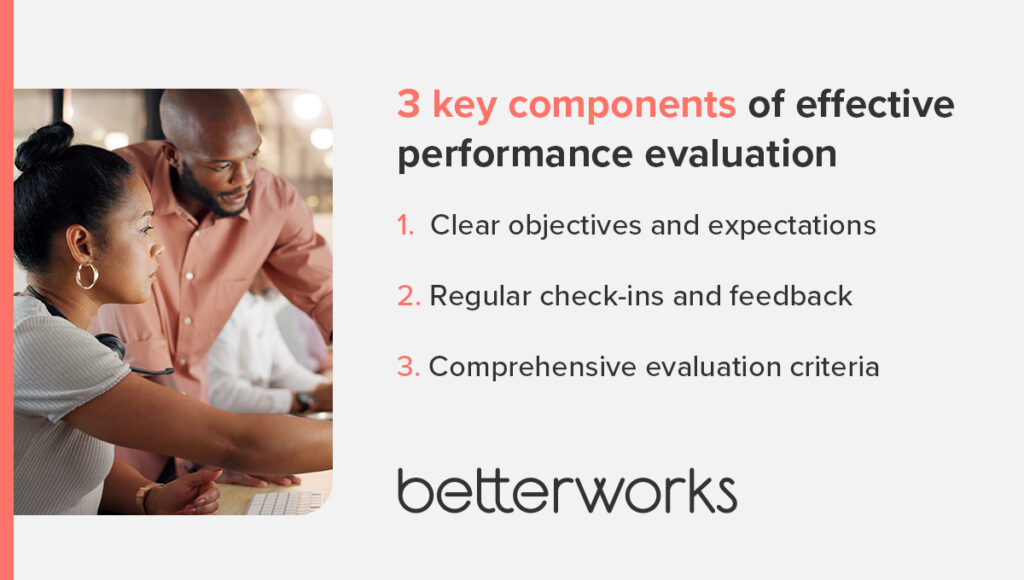
Breaking down different employee performance evaluation processes
Traditional performance management processes rely on an annual review cycle. But you aren’t limited to once-a-year performance conversations. Consider the following performance management evaluation methods, including alternatives to performance reviews, and their utility in today’s workplace.
Traditional annual reviews
Traditional annual performance reviews have been the norm in many organizations for years. These once-a-year meetings allow managers to evaluate an employee’s performance over the past year. However, this method has its downsides.
Annual reviews can be problematic because they often rely on what managers remember, which can be biased and may miss key contributions. Additionally, waiting an entire year for feedback can leave employees feeling unsupported and disengaged. This delay in addressing issues or recognizing achievements can hinder motivation and timely improvements.
Continuous performance management
The shift towards continuous performance management is transforming how organizations handle employee development. Instead of waiting for annual reviews, you can provide ongoing feedback and support, which helps employees stay aligned with their goals and the company’s objectives. This regular interaction keeps everyone more engaged and motivated, fostering a culture of continuous improvement.
With continuous performance management, you can address issues as they arise and recognize achievements in real time. This approach not only boosts productivity but also enhances employee satisfaction by making employees feel valued and supported throughout the year.
360-degree feedback
360-degree feedback is a comprehensive evaluation method in which you gather feedback from an employee’s peers, subordinates, and managers, along with self-assessments.
This multi-source approach can provide insights that might be overlooked in traditional evaluations. They’re also time-consuming and vulnerable to bias.
If your organization is currently or is considering using this model, make sure you fully understand the pros and cons of 360 reviews.
What’s the best approach for performance reviews?
Betterworks takes a modern approach to employee performance evaluations, focusing on continuous performance management and performance enablement. We recognize the importance of ongoing feedback and support to help employees stay aligned with their goals and the company’s objectives. This approach involves regular check-ins, real-time feedback, and a balanced mix of qualitative and quantitative measures.
Betterworks’ performance management software integrates these elements, providing tools for goal setting, tracking, and feedback. This system transforms traditional evaluations into a dynamic, supportive process that drives both employee development and organizational success. And it does so in a way that’s not onerous or time-consuming. Conversations are lightweight check-ins that employees and managers can easily and quickly note in the system, along with goal progress and updates. By fostering a culture of continuous feedback and open communication, Betterworks helps you create more effective and fair performance evaluations.
Choosing the right employee performance evaluation tool
The right modern performance management software supports effective employee performance evaluations. “There’s a lot of great performance management tools out there,” says Ashley Litzenberger, senior director of product marketing at Betterworks. “What you need to think about is: What size is your organization? What kinds of applications do you need that software to do?”
Look for the following features as you consider software to support employees and managers in driving performance.
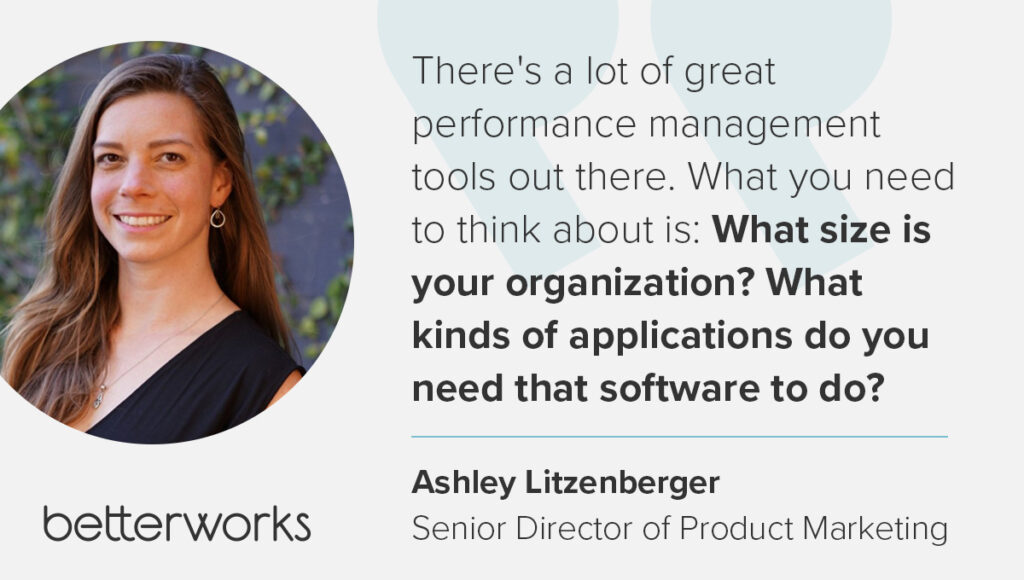
Goal setting and tracking
Your software should allow employees to set clear, measurable goals and easily track their progress against them. This helps employees understand expectations and stay aligned with company objectives, making sure everyone is working toward the same targets. Good software will allow you to update and adjust goals as needed, ensuring they remain relevant and attainable throughout the evaluation period.
Continuous feedback
Regular check-ins and real-time feedback are crucial for improving employee performance and keeping people engaged in their work. Software that facilitates ongoing feedback helps address issues as they arise, rather than waiting for annual reviews. This continuous loop of communication provides employees with timely recognition and constructive criticism, which aids in their development and keeps them aligned with company goals.
Data analytics
Robust data analytics capabilities are essential for generating insights from performance metrics. This feature allows managers to make data-driven decisions and provides a clear, objective basis for evaluations. Analytics can highlight trends, identify strengths and weaknesses, and uncover areas for improvement, providing a fair and comprehensive basis for performance evaluations, as well as direction for strategic growth.
“You can go back, look at trends, and see, ‘Here are teams that are performing really well, or here are individuals that are performing really well. Here is how they think, how they feel about their roles and organizations,’” Ashley says. “How do we start to build up that same set of experiences for other people to help drive performance?” You need the right data to answer these critical strategic questions.
User-friendly interface
An intuitive, easy-to-use platform is important for ensuring that both managers and employees can effectively use the software. A user-friendly interface encourages consistent use and flattens the learning curve, making it easier to integrate the software into daily workflows. This leads to higher adoption rates and thus, more frequent and reliable employee performance data.
Customization and integration
The ability to customize the software to fit your specific needs and integrate with other HR systems is crucial. Customization ensures the software can adapt to the unique processes and requirements of your organization, while integration allows for a seamless flow of data across different platforms. This creates a more cohesive performance management system, reducing redundancy and improving efficiency.
6 best practices for performance evaluation
A fair, comprehensive performance management process that aligns with business goals doesn’t happen by accident.
And while every organization has different needs based on their size, culture, stage of growth and more, there are a few best practices that can benefit any organization.
Involve your employees
Involving employees in performance evaluations is key to effectively managing employee performance. When employees take part in their evaluations through self-assessments and feedback discussions, they feel a sense of ownership and responsibility for their development. This engagement boosts motivation and productivity, as employees clearly understand their goals and areas for improvement.
To involve employees effectively, encourage them to share their achievements and challenges regularly. Facilitate open, two-way conversations where they can voice their perspectives and collaborate with their managers to set realistic goals. Provide resources, such as sample self-evaluations for performance reviews, to encourage employees to think more strategically about their performance and potential.
Incorporate peer feedback
Performance feedback from peers and teammates can provide a more comprehensive and accurate picture of an employee’s performance. Peers often have a closer view of day-to-day activities and can offer insights that managers might miss.
The research bears that out: Employees who get feedback from their team in reviews are 2-4.5 times more likely to feel those reviews are unbiased, our 2023 State of Performance Enablement report reveals. This broader perspective fosters a culture of fairness and inclusivity, ultimately leading to higher levels of trust and engagement within your organization.
Train managers
Training managers is crucial for effective performance evaluations because it equips them with the skills to provide accurate, constructive feedback and support their teams’ growth. Well-trained managers can better identify strengths and areas for improvement, fostering a culture of continuous development.
To train managers effectively, offer workshops and resources on performance management best practices. Provide tools, such as employee performance evaluation templates, to help managers learn what to prioritize during performance assessments. Encourage role-playing exercises to practice delivering feedback and handling difficult conversations.
Finally, encourage managers to practice modeling a proactive approach to feedback. “If you’re nervous about providing feedback, start asking for it,” suggests Caitlin Collins, organizational psychologist and program strategy director at Betterworks. “Focus on something that you care about that you know that you want to improve.” By asking their teams for feedback, managers set the example, and make it clear that they view feedback as a resource for improving their own performance.
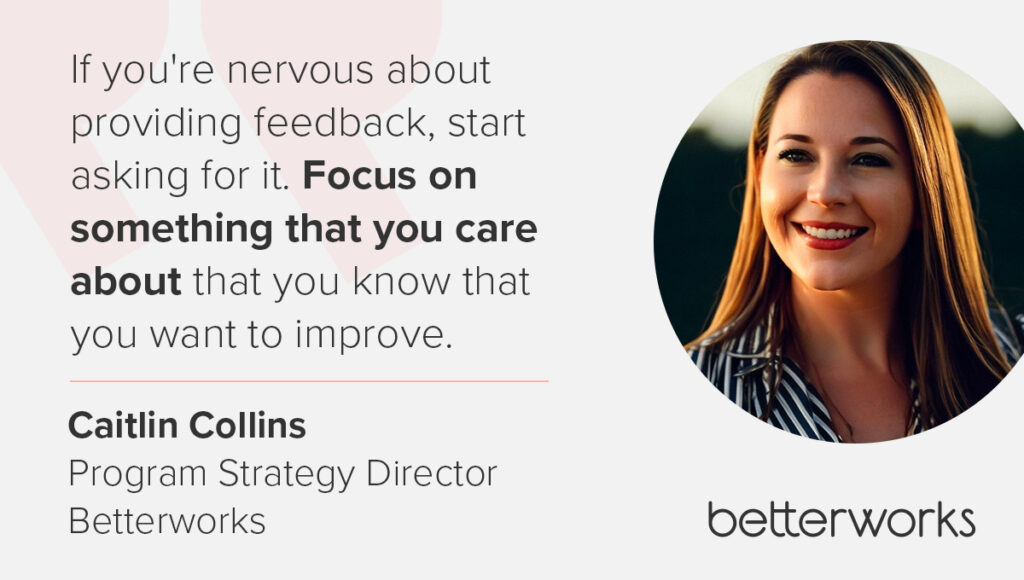
Support career development
Supporting career development is essential to the performance evaluation process because it aligns employee growth with organizational goals, enhancing both engagement and retention. “Feedback is a catalyst that is meant to really push people to develop and improve their performance, and grow into new roles or improve and grow and develop in the role that they’re in,” Caitlin says. When you prioritize career development, employees feel valued and motivated, knowing they have a clear path for advancement.
To do this, incorporate development plans into evaluations, setting goals that align with employees’ career aspirations. Provide opportunities for training, mentorship, and skill-building. Regularly review progress and adjust plans as needed. This approach ensures that employees are continuously growing and contributing to the organization’s success, creating a win-win situation.
Provide data-driven insights
Providing data-driven insights is crucial for promoting objectivity in goal, evaluation, and feedback processes. When you base evaluations on concrete data, you minimize biases and provide a clear, accurate picture of an employee’s performance. This helps build trust in the evaluation process and supports informed decision-making.
To do this, use performance management software that collects and analyzes data on key performance indicators. Regularly review and share these insights with employees and managers, helping them understand their progress and areas for improvement. This approach promotes transparency and drives continuous development.
Assess and adapt
Assessing and adapting your performance evaluation process is crucial for maintaining its effectiveness and relevance. Regularly reviewing your evaluation methods helps identify areas for improvement, ensuring they continue to meet the needs of your organization and employees.
To assess your process, gather feedback from managers and employees, and analyze performance data to identify trends and gaps. Use this information to make necessary adjustments, such as incorporating new evaluation tools or updating performance criteria. By continually refining your approach, you create a dynamic and supportive performance management system that drives employee growth and organizational success.
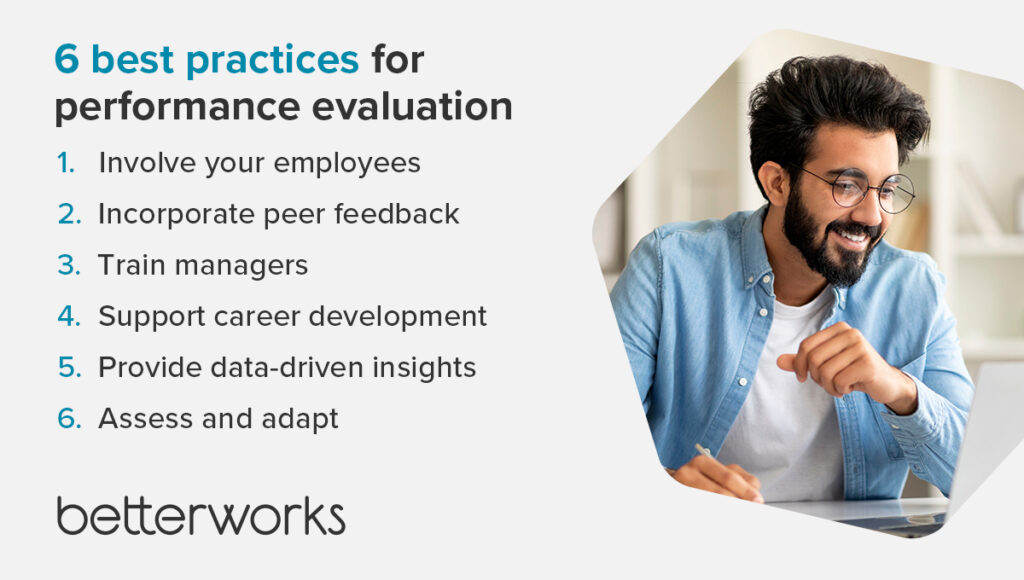
Final thoughts: Elevating performance evaluation practices
Effective performance evaluations are a useful tool for driving business success. They provide a structured way to assess and improve individual performance while aligning employee goals with organizational objectives. This approach not only enhances productivity but also fosters a culture of growth and motivation, ultimately contributing to overall organizational success.
Employee performance evaluation FAQ
We’ve compiled a list of frequently asked questions to help you navigate the complexities of employee performance evaluations.
What is the purpose of employee performance evaluation?
The purpose of employee performance evaluation is to assess and improve individual performance, align employee goals with organizational objectives, and provide continuous feedback for development. This process helps identify strengths and areas for improvement, fostering growth and enhancing overall productivity and engagement within the organization.
How do you implement effective performance evaluation methods?
Implement effective performance evaluation methods by setting clear, measurable goals, facilitating frequent feedback from managers, and delivering data-driven insights to help employees adapt their performance in real time. Use performance management software to streamline and support these practices and foster a culture of continuous improvement and development.
What are the best tools for employee performance evaluation?
The best tools for employee performance evaluation include performance management software with features for goal setting and tracking, conversations and feedback, recognition, and data analytics. Look for tools that offer user-friendly interfaces and integration capabilities to guarantee a seamless and effective evaluation process that promotes continuous improvement. Performance management tools should be accessible via the applications employees use every day (in the flow of work) to improve adoption and make the tools easy to use.
Discover how Betterworks can help you elevate your performance management system.
Leave the old ways behind. Elevate performance.

